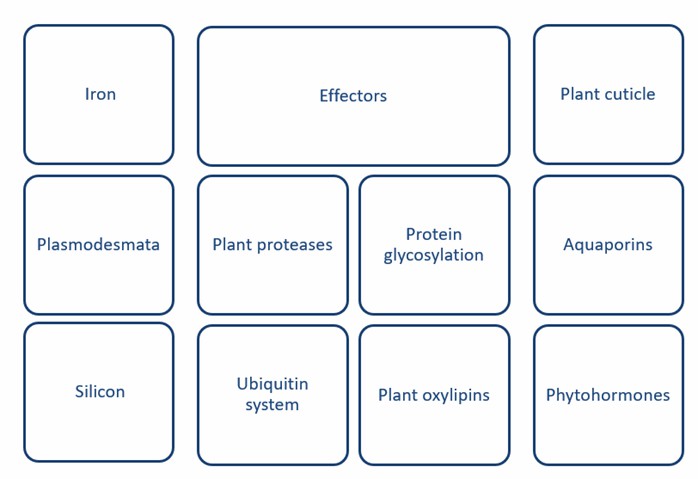Numerous factors play key roles in plant-pathogen interactions. Lifeasible offers services to help detect these key factors and study their roles in plant-pathogen interactions.
Several factors in plants or pathogens significantly influence plant-pathogen interactions. For example, the uptake, transport, storage, and regulation of iron by plants and pathogenic organisms influence the interaction between plants and pathogens. Effectors can mask pathogens to avoid recognition or attack, resist to plant immunoreactive substances, interfere with host plant physiological activities, and manipulate plant immune signaling. These effectors significantly influence pathogen-plant interactions. Furthermore, adjustments in some parts of the plant cell, such as plant cuticles, plasmodesmata, and aquaporins, influence plant-pathogen interactions. Detecting these influencing factors and exploring the mechanisms of their effects can help develop new plant protection solutions. Lifeasible offers professional services to help detect factors affecting plant-pathogen interactions and explore the mechanisms.
 Fig. 1 Key factors in plant-pathogen interactions.
Fig. 1 Key factors in plant-pathogen interactions.
We mainly offer services for 11 key factors that affect plant-pathogen interactions. Please let us know if there is a need for other key factor studies in plant-pathogen interactions.
| Key factors | Service details |
| Iron | Iron homeostasis is crucial both in plants and pathogens. Competition between plants and pathogens for iron influences their interactions. We help investigate genes that affect iron homeostasis, iron regulation strategies in plants for resisting pathogens, and the strategies of iron uptake by pathogens to infect plants. |
| Plant proteases | Protease-mediated proteolysis is a key factor in the regulation of precision signaling. Plant proteases can regulate various immune signaling pathways. We offer services to help explore the initial role of a specific plant protease and its mechanisms of action and targets. |
| Effectors | Pathogen effectors are major factors in the virulence of pathogens and greatly influence plant-pathogen interactions. We offer services to help identify and discover pathogen effectors, characterize their functions, and explore their mechanisms of action. |
| Plant cuticle | The plant cuticle is vital as a resistance structure for plants against pathogen invasion. We help to analyze the structure of the plant cuticle and explore the factors that influence it. |
| Plant oxylipins | Plant oxylipins play developmental and defensive roles. We help analyze plant oxylipins and explore their signaling and non-signaling effects. |
| Aquaporins | Plant aquaporins greatly influence plant immunity, while pathogen aquaporins influence the growth and pathogenicity of pathogens. We offer services to help discover plant and pathogen aquaporins and explore their functions. |
| Plasmodesmata | Plasmodesmata (PD) connect adjacent cells of plants and not only maintains communication between plant cells but also control metabolite partitioning. We help to detect the state of PD and explore the factors that influence its state, including the accumulation of callose, PD-located regulators of plasmodesmal permeability, and PD-related genes. |
| Silicon (Si) | A plant’s ability to absorb and translocate Si affects its ability to resist pathogens. We help analyze Si in plants and explore the specific role of Si in plant-pathogen interactions. |
| Phytohormones | Phytohormones are key players in plant growth and immune regulation, and we offer services to help detect a wide range of phytohormones and explore their role in plant-pathogen interactions. |
| Protein glycosylation | Protein glycosylation can alter protein conformation, activity, and stability, greatly affecting the interactions between plants and pathogens. We offer services to help detect the glycosylation of plant and pathogen proteins and explore the impact of glycosylation on plant-pathogen interactions. |
| Ubiquitin system | The ubiquitin system is involved in numerous critical cellular processes in eukaryotes. The ubiquitin system is closely associated with plant resistance. Some pathogens hijack the plant ubiquitin system to increase its virulence. We help detect and validate protein ubiquitination, explore the function of ubiquitinated proteins and detect proteins or molecules that interact with the ubiquitin system. |
Lifeasible provides professional plant-pathogen interaction research services, and we can achieve studies of several key factors in plant-pathogen interactions. Some key factors interact with each other in plant-pathogen interactions. We can also achieve interaction studies between these factors. Please contact us for customized services.